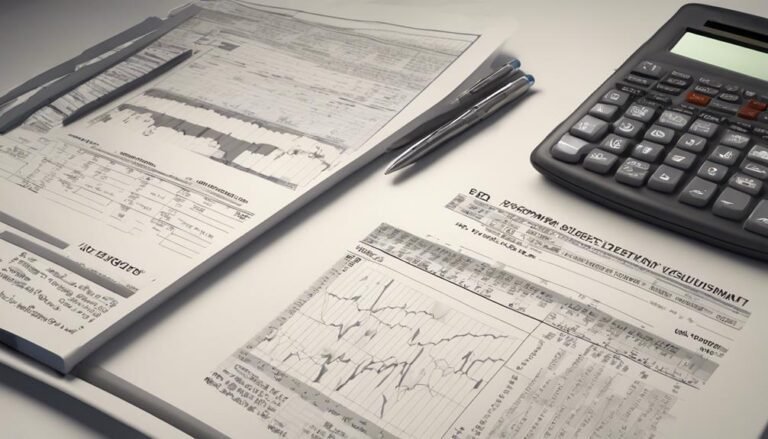Environmental, Social, and Governance (ESG) Reporting in Accounting
In today's accounting landscape, embracing Environmental, Social, and Governance (ESG) Reporting is vital for demonstrating your dedication to sustainability and transparency. Not only does it influence how stakeholders perceive your company, but it also integrates ESG factors for regulatory compliance and a competitive edge. By providing a detailed perspective on performance across ESG metrics, it helps pinpoint areas for growth and tracks progress over time. This enhances credibility with investors, customers, and employees, fostering trust and loyalty. Understanding the ins and outs of ESG Reporting is a strategic move that can set you apart in the evolving landscape of accounting.
Key Takeaways
- ESG reporting integrates sustainability factors into financial disclosures.
- Enhances transparency and accountability for stakeholders.
- Demonstrates commitment to environmental and social responsibility.
- Aligns with regulatory requirements and investor demands.
- Improves risk management and long-term value creation.
Importance of ESG Reporting
Highlighting the significance of ESG reporting is crucial for organizations aiming to demonstrate their commitment to sustainability and transparency in today's dynamic business landscape. The implementation of robust ESG reporting practices can have a profound impact on how a company is perceived by stakeholders. By strategically integrating ESG factors into their reporting framework, organizations can't only meet regulatory requirements but also gain a competitive edge in the market.
The strategy behind ESG reporting lies in its ability to provide a detailed view of an organization's performance across environmental, social, and governance metrics. This holistic approach enables companies to identify areas for improvement, set meaningful targets, and track progress over time. Furthermore, transparent ESG reporting can enhance credibility with investors, customers, and employees, fostering trust and loyalty.
Evolution of Reporting Standards
As you explore the Evolution of Reporting Standards, consider delving into the rich history of reporting standards and how they've shaped the current landscape.
Look ahead to emerging trends in reporting, anticipating how future standards may evolve to meet the changing needs of stakeholders.
Understanding this evolution will provide valuable insights into the trajectory of ESG reporting in accounting.
Reporting Standards History
Throughout the evolution of reporting standards in accounting, a clear progression can be observed from traditional financial reporting to the incorporation of Environmental, Social, and Governance (ESG) factors. The ESG reporting timeline has been shaped by various regulatory influences pushing for greater transparency and accountability in corporate reporting. Below is a table summarizing key moments in the development of ESG reporting standards:
| ESG Reporting Timeline | Regulatory Influences |
|---|---|
| Early 2000s | Introduction of GRI Standards |
| 2010 | UN Global Compact |
| 2015 | Paris Agreement |
| Present | SASB and TCFD Frameworks |
The ESG reporting landscape has evolved significantly over the years, with organizations now recognizing the importance of not only financial performance but also their impact on the environment and society. As regulatory bodies continue to emphasize the need for in-depth ESG disclosures, companies are increasingly integrating these factors into their reporting practices to meet stakeholder demands and contribute to sustainable business practices.
Future Reporting Trends
The evolution of reporting standards in accounting has paved the way for future trends in ESG reporting, signaling a shift towards more thorough and integrated disclosures. As technology integration continues to advance, companies are leveraging digital tools to streamline data collection and reporting processes, enhancing the accuracy and efficiency of ESG disclosures. This integration not only facilitates better data management but also enables real-time reporting, meeting stakeholders' demands for up-to-date information.
Stakeholder engagement is becoming a focal point for organizations looking to strengthen their ESG reporting practices. By actively involving stakeholders in the reporting process, companies can gather valuable insights, improve transparency, and enhance credibility in the eyes of investors and the public.
Global harmonization efforts are underway to standardize ESG reporting frameworks across borders, promoting consistency and comparability. As regulatory changes increasingly emphasize the importance of ESG disclosures, companies are adapting their reporting strategies to comply with evolving requirements and meet the growing demand for accountability and sustainability.
Key Components of ESG Reporting
When considering the key components of ESG reporting, it's essential to focus on the ESG framework overview, reporting standards used, and data collection methods.
Understanding the framework provides a foundational understanding, while the standards utilized promote consistency and comparability.
Efficient data collection methods are vital for accurate and reliable ESG reporting practices.
ESG Framework Overview
In understanding ESG reporting, it is essential to grasp the key components of the ESG framework. When comparing ESG frameworks, various tools are available to aid in reporting effectively. Here is a brief overview of the key components of ESG reporting frameworks:
| ESG Framework Comparison | ESG Reporting Tools |
|---|---|
| GRI (Global Reporting Initiative) | Sustainability Accounting Standards Board (SASB) |
| TCFD (Task Force on Climate-Related Financial Disclosures) | CDP (Carbon Disclosure Project) |
| UN Global Compact Principles | ESG rating agencies like MSCI and Sustainalytics |
The GRI framework focuses on detailed reporting, while TCFD emphasizes climate-related disclosures. UN Global Compact Principles guide companies on human rights, labor, and anti-corruption. SASB provides industry-specific standards, CDP focuses on environmental impact, and ESG rating agencies assess overall sustainability performance. Understanding these frameworks and utilizing the right tools can enhance the quality and comparability of ESG reports, enabling stakeholders to make informed decisions regarding a company's environmental, social, and governance practices.
Reporting Standards Used
To enhance the quality and comparability of ESG reports, it's essential to understand and utilize the key reporting standards in the industry. When comparing ESG reporting with sustainability reporting, it's important to note that while sustainability reporting often focuses on environmental and social aspects, ESG reporting adds the governance component, offering a more holistic view of a company's performance.
The most commonly used reporting standards in ESG reporting include the Global Reporting Initiative (GRI), Sustainability Accounting Standards Board (SASB), and Task Force on Climate-related Financial Disclosures (TCFD). Each of these standards provides a framework for companies to disclose relevant ESG information systematically.
However, despite the benefits of using these standards, companies may face implementation challenges in ESG reporting. These challenges can range from data collection difficulties to the need for internal capacity building. Overcoming these challenges requires a strategic approach, clear communication with stakeholders, and a commitment to transparency in reporting practices. By addressing these challenges, companies can improve the quality and effectiveness of their ESG reporting.
Data Collection Methods
For efficient ESG reporting, identifying and implementing robust data collection methods is essential in providing accurate and detailed insights into a company's environmental, social, and governance performance. Survey methods play a significant role in gathering information directly from stakeholders, employees, customers, and communities. These methods can include online surveys, interviews, focus groups, and questionnaires tailored to capture specific ESG-related data points.
Ensuring data accuracy is critical in ESG reporting to maintain credibility and transparency. Companies often utilize automated data collection tools and software to streamline the process and minimize errors. Validating the collected data through independent audits and verification processes further enhances its reliability.
Additionally, integrating data collection methods with existing internal systems can facilitate ongoing monitoring and reporting, enabling organizations to track their ESG performance consistently. By leveraging survey methods and prioritizing data accuracy, companies can enhance the quality of their ESG reporting and demonstrate a commitment to sustainable practices.
Integration With Financial Reporting
An effective approach to integrating ESG reporting with financial reporting involves aligning key performance indicators and material sustainability metrics to provide a holistic view of an organization's overall value creation. Financial integration guarantees that sustainability metrics aren't only disclosed but also linked to financial performance, offering stakeholders a thorough understanding of how ESG factors impact the bottom line. By incorporating ESG disclosure into financial reporting, companies can demonstrate their dedication to long-term value creation and risk management strategies.
When integrating ESG reporting with financial reporting, strategic alignment is vital. Organizations must identify relevant sustainability metrics that align with their financial goals and key performance indicators. This alignment enables companies to communicate a coherent narrative to investors, regulators, and other stakeholders about how sustainability practices contribute to financial outcomes. Additionally, by integrating sustainability metrics into financial reporting processes, companies can enhance transparency and accountability, showcasing their commitment to sustainable business practices and value creation. This integrated approach not only strengthens stakeholder trust but also positions organizations as leaders in sustainable finance and responsible business operations.
Challenges in ESG Data Collection
Effective ESG data collection presents numerous challenges that organizations must tackle to guarantee the accuracy and reliability of sustainability reporting. One significant challenge is the lack of standardized metrics and frameworks for ESG data, leading to inconsistencies in data collection and reporting. Another obstacle is the vast amount of data sources available, making it difficult for organizations to determine which data points are most relevant and material to their ESG performance.
Solutions to these challenges involve implementing robust data management systems that can handle large volumes of diverse data sources. Organizations can also benefit from investing in technology tools like ESG software platforms that streamline data collection, analysis, and reporting processes. Additionally, fostering collaboration between different departments within the organization can help make sure that all relevant ESG data is captured effectively.
Benefits of ESG Reporting for Businesses
Exploring the landscape of ESG reporting can prove to be a transformative journey for businesses, revealing a myriad of benefits that extend beyond just sustainability. Embracing ESG reporting comes with significant business incentives. By disclosing ESG performance, companies can enhance their reputation, attract ethical investors, and potentially lower their cost of capital. Additionally, engaging with stakeholders through ESG reporting fosters transparency and trust, which can lead to improved relationships with customers, employees, and communities.
In addition to the immediate advantages, ESG reporting also enables businesses to align their operations with sustainability initiatives. This alignment not only helps in meeting regulatory requirements but also future-proofs the organization against evolving environmental and social challenges. Companies that prioritize ESG reporting often find themselves better positioned to capitalize on emerging market trends and mitigate risks associated with climate change and social issues. Embracing ESG reporting isn't only a responsibility but also a strategic move that can drive long-term success and resilience.
Investor Perspectives on ESG
Investors are increasingly prioritizing Environmental, Social, and Governance (ESG) factors when evaluating potential investments. Investor engagement plays an essential role in shaping companies' ESG performance. Shareholder activism has also been on the rise, with investors using their influence to push for greater transparency and accountability in ESG practices. Sustainability metrics have become key indicators for investors evaluating the long-term viability and risk profiles of companies.
When investors consider ESG factors, they're looking beyond traditional financial metrics to gain a thorough understanding of a company's operations and impact. They evaluate how well a company manages environmental risks, treats its employees, and upholds ethical standards in governance. This holistic approach allows investors to identify opportunities and risks that may not be captured solely through financial analysis.
Future Trends in ESG Reporting
Anticipate emerging shifts in ESG reporting practices to stay ahead in the evolving landscape of sustainable finance. As you navigate the future trends in ESG reporting, keep in mind the following key points:
- Innovative Technologies: Embrace the use of advanced technologies such as AI and blockchain to enhance data collection, analysis, and reporting processes. Leveraging these tools can streamline ESG reporting and provide more accurate insights into your organization's sustainability performance.
- Enhanced Stakeholder Engagement: Focus on increasing transparency and engagement with stakeholders to build trust and credibility. As emerging regulations emphasize the importance of stakeholder communication, proactively involving them in your ESG reporting can strengthen your relationships and reputation.
- Integrated Reporting Frameworks: Look towards adopting integrated reporting frameworks that combine financial and non-financial information. By aligning ESG metrics with financial performance, businesses can present a more holistic view of their value creation to investors and stakeholders.
- Compliance with Emerging Regulations: Stay informed about the evolving landscape of ESG regulations to ensure adherence and mitigate risks. Adapting your reporting practices to meet new requirements won't only demonstrate your dedication to sustainability but also safeguard your organization from potential legal implications.
Conclusion
In summary, ESG reporting is essential for businesses to showcase their dedication to sustainability, transparency, and ethical practices. It's the compass that guides organizations towards a brighter future, like a lighthouse guiding ships through turbulent waters.
By embracing ESG reporting, companies can't only attract ethical investors but also drive positive change in society and the environment. Stay focused on ESG reporting, and your journey towards success will be smooth sailing ahead.








